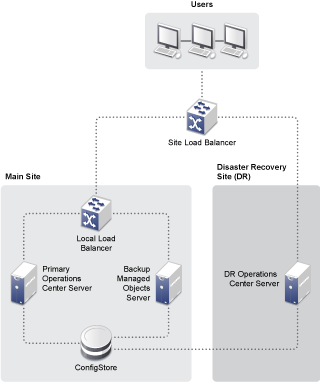6.3 Implementing a High Availability/Disaster Recovery (Hot/Hot) Configuration
This section describes a standard methodology for creating and maintaining a High Availability/Disaster Recovery configuration for a Operations Center implementation. It serves as a starting point for the creation of a site-specific High Availability implementation plan that can be customized, as required, for your environment.
A Hot/Hot type of architecture is required to implement a High Availability (HA) configuration of “high nines.” This requires that there be two (at a minimum) identically configured systems that are up and running and available to users, as well as a separate Disaster Recovery platform. For example:
Figure 6-2 High Availability/Disaster Recovery Configuration

6.3.1 Servers
Table 6-1 describes the recommended configuration to meet the HA requirements, as well as additional requirements around system upgrades, maintenance, and so on.
Table 6-1 HA Configuration Requirements
|
Server Sites |
Servers Required |
|---|---|
|
Main Site |
Primary Server: An Operations Center Server with all adapters, Service Models, Users/Groups, SCM definitions, BSLM definitions and Dashboards. Backup Server: One additional Server with a “mirrored” image of the Primary Server. |
|
Disaster Recovery Site |
Disaster Recovery Server: An additional Server, a “mirrored” image of the Primary Server. |
For the above architecture:
-
All Operations Center Servers are configured with the option turned on and use the same backend databases for the configStore and Service Warehouse
-
The backend database requires a separate, third-party Hot/Hot clustering technology specific to that database implementation
6.3.2 Load Balancers for Traffic Management
The use of a load balancer is recommended for traffic management with a Hot/Hot solution. A local load balancer is placed in front of the Primary and Backup Server in the Main Site. An additional load balancer is added in front of the Main Site to direct users to the Disaster Recovery site in the event of a complete site outage.
Users log in to the Operations Center server via the Site Load Balancer. The Site Load Balancer directs the user either to the Primary (if running) Operations Center server or to the Backup Operations Center server if the Primary is down. If both the Primary and Backup servers are down, users are directed to the DR Operations Center server.
While load balancing solutions are available from vendors, such as F5Networks, Cisco, and Symantec, Operations Center does not recommend any particular vendor, brand, make or model.
6.3.3 Backend Database
The backend database, that houses the configStore and Warehouse, requires its own High Availability configuration based on available offerings. If failover can be handled by another database server, instead of using backups to restore the database, downtime can be shortened considerably.
Review solutions offered by your database manufacturer as many vendors offer standard clustering options that can provide for either Hot/Cold or Hot/Warm database methodologies. For example, this can include a shared disk for the database files and two servers utilizing the shared disk subsystem to provide the database role.